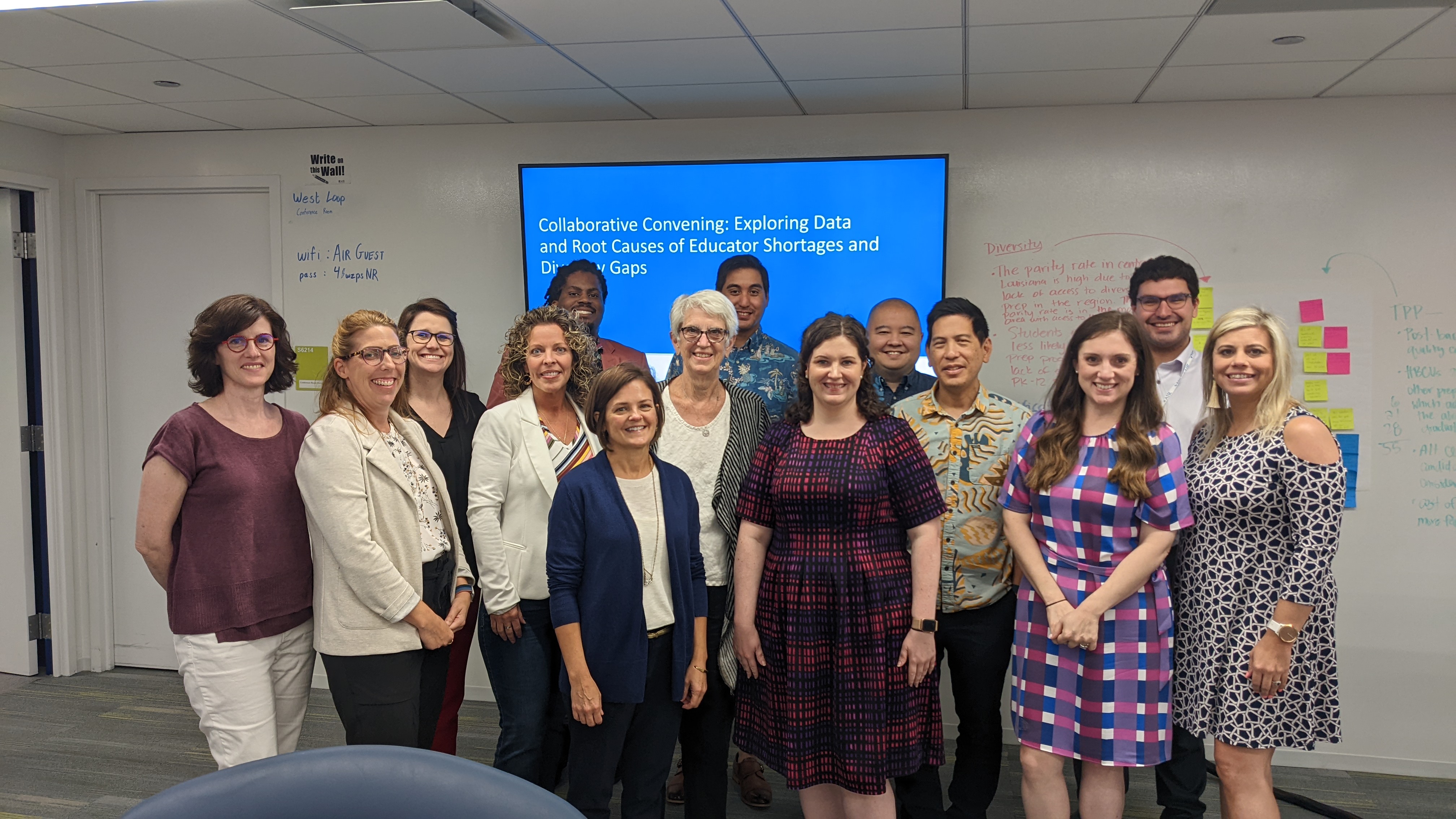GTL Center National Collaborative: Accelerating Data-Driven Policy and Practice to Address Educator Shortages and Educator Diversity
Collaborating to implement data-driven strategies to address educator shortages and workforce diversity.
Featured Resource
New federal funding presents a once-in-a-lifetime opportunity to make a substantial impact for the students who are most effected by educator shortages and the lack of diversity in classrooms. This resource highlights strategies to leverage federal relief funding to engage stakeholders in a data-driven equity-focused approach to address educator shortages and workforce diversity.
Client
Ohio Department of Education
Hawaii State Department of Education
Louisiana Department of Education
Project
Facilitated a two year collaborative data-driven coaching and facilitation process with state teams to identify solutions to state challenges related to educator shortages and educator diversity.
Outcome
As a result of this collaborative, teams will create policy, practices, and plans that: are data-driven, equity-focused, and built for sustainability with stakeholders engaged throughout the process; prioritize evidence-based strategies designed to address the root causes of shortages and gaps in each context; and strengthen and diversify the educator workforce in underserved school communities.
Team
Lisa Lachlan, GTL Center Project Lead
Jessica Giffin, GTL Center
Cheryl Krohn, GTL Center
Keane Alavi, GTL Center
D'mari Creque, GTL Center
The Challenge
 Districts across the country have been plagued by a chronic shortage of teachers, and with the advent of the coronavirus disease 2019 (COVID-19) pandemic, shortages likely have been exacerbated. Schools are unable to fill teaching positions, and consequently students do not have fully prepared teachers in the classroom. Early retirement in some districts has increased dramatically, and enrollment in teacher preparation programs has declined. Given that the shortage of effective teachers disproportionately impacts students who are at a disadvantage in both schools and society, states and districts are in a critical position to use American Rescue Plan Act funds to address these equity and opportunity gaps.
Districts across the country have been plagued by a chronic shortage of teachers, and with the advent of the coronavirus disease 2019 (COVID-19) pandemic, shortages likely have been exacerbated. Schools are unable to fill teaching positions, and consequently students do not have fully prepared teachers in the classroom. Early retirement in some districts has increased dramatically, and enrollment in teacher preparation programs has declined. Given that the shortage of effective teachers disproportionately impacts students who are at a disadvantage in both schools and society, states and districts are in a critical position to use American Rescue Plan Act funds to address these equity and opportunity gaps.
The Opportunity
As education leaders make strategic and comprehensive investments to support and strengthen the educator workforce, they need to consider engaging in proactive, targeted, and purposeful policy and practice that are grounded in their unique needs and contexts. Such engagement should include a data-driven approach, as outlined in the center's Talent Development Framework.
To do this work well, the GTL Center is engaging state teams in a 2-year process that will build on current efforts by leveraging the deep expertise of content experts and engage education leaders in the use of GTL-designed tools that support data-driven, equity-focused decision making. Teams are comprised of five to seven stakeholders (e.g., local education agency [LEA], state education agency [SEA], education preparation provider [EPP], and other leaders supporting the educator career continuum) that will partner with the GTL Center team to accomplish the following:
- Engage stakeholders in the GTL Center’s data-driven, equity-focused approach to strengthen and diversify the educator workforce.
- Develop geographic information system (GIS) maps to identify regional or local challenges and opportunities to address shortages and the lack of diversity.
- Strengthen current talent management policies and programs using an equity-focused lens.
- Design and implement action plans based on problems of practice highlighted through the GTL approach.
- As appropriate, develop plans for progress monitoring, provide district staff with coaching and feedback on educator workforce plans, and create resources and guidance related to closing educator shortage and diversity gaps.
Throughout the collaborative, teams will engage in peer-to-peer consultancies, focused team time, presentations and coaching from subject-matter experts (SMEs), a review of examples of evidence-based practices, and opportunities to share progress and review peer resources, while also providing insights and ideas to other teams (see Project Outline below for more details).
The Approach
The Center on Great Teachers and Leaders (GTL Center) plans to implement a multi-step process with participating states that allow states to create a locally driven, evidence-based action plans for improving the diversity of their educator workforce and address educator shortages.
Step 1. Data Analysis
Utilize Geographic Information System (GIS) Mapping, to measure, analyze, and visualize existing educator workforce diversity gaps across the educator career continuum and at the state, district, school, and Educator Preparation Program (EPP) levels.
Step 2. Root Cause Analysis
Use a modified-version of the GTL Center's Root Cause Analysis Workbook to consult with educators and other stakeholders to identify the underlying root causes for identified gaps.
Step 3. Evidence-based Strategy Selection
Link identified root causes with evidence-based, high-impact strategies like mentoring and induction and teacher leadership models and determine a timeline for implementation.
Step 4. Implementation, Monitoring, and Continuous Improvement
Explore the GTL Center's Evidence-Based Strategies or action planning and implementation tools for high-leverage strategies. Monitor intended and unintended consequences to ensure that the strategies are effective in accomplishing the identified goals.




